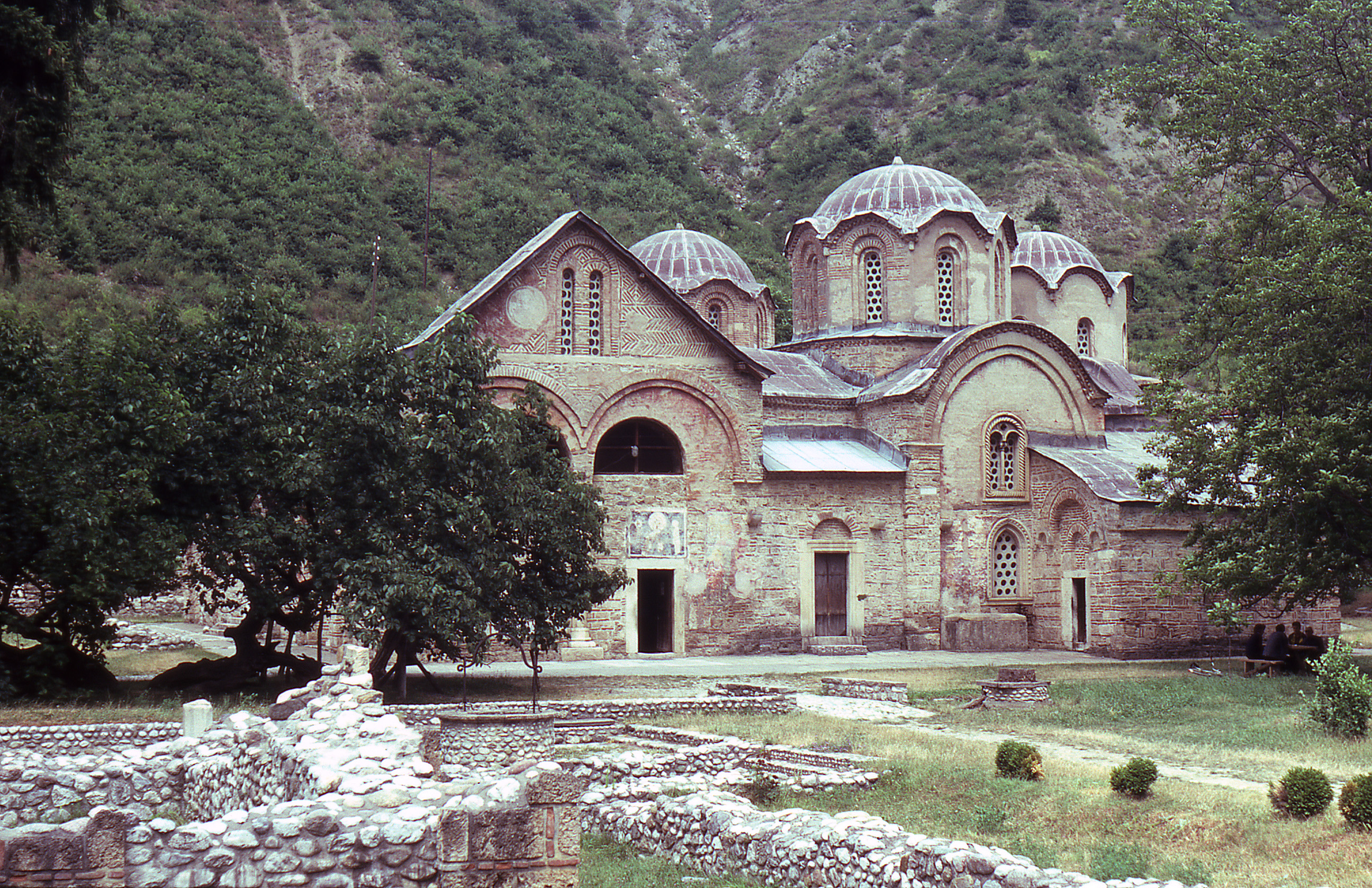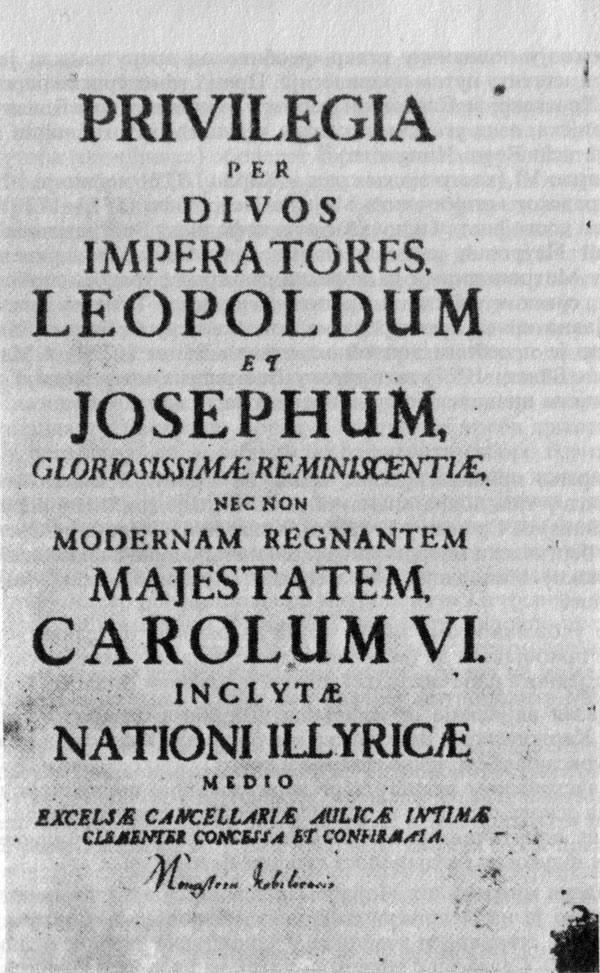|
Arsenije III Crnojević
Arsenije III Crnojević ( sr-cyr, Арсеније III Црнојевић; 1633 – 27 October 1706) was the Archbishop of Peć and Serbian Patriarch from 1674 to his death in 1706. In 1689, during the Habsburg-Ottoman War (1683–1699), he sided with Habsburgs, upon their temporary occupation of Serbia. In 1690, he left the Patriarchal Monastery of Peć and led the Great Migration of Serbs from Ottoman Serbia into the Habsburg monarchy. There he received three charters (the "''Serbian Privileges''" of 1690, 1691, and 1695), granted to him by Emperor Leopold I, securing religious and ecclesiastical autonomy of Eastern Orthodoxy in the Habsburg Monarchy. In the meanwhile, after restoring their rule in Serbian lands, Ottomans allowed the appointment of a new Serbian Patriarch, Kalinik I (1691–1710), thus creating a jurisdictional division within the Serbian Orthodox Church. Until death, in 1706, Patriarch Arsenije remained the head of Serbian Orthodox Church in Habsburg lands ... [...More Info...] [...Related Items...] OR: [Wikipedia] [Google] [Baidu] |
Serbian Patriarchate Of Peć
The Serbian Patriarchate of Peć ( sr, Српска патријаршија у Пећи, ''Srpska patrijaršija u Peći'') or just Patriarchate of Peć ( sr, Пећка патријаршија, ''Pećka patrijaršija''), was an autocephaly, autocephalous Eastern Orthodox Patriarchate that existed from 1346 to 1463, and then again from 1557 to 1766 with its seat in the Patriarchal Monastery of Peć. It had ecclesiastical jurisdiction over Eastern Orthodox Christians in Serbian Lands and other western regions of Southeastern Europe. Primates of the Patriarchate were styled ''Archbishop of Peć and Serbian Patriarch''. Medieval Period (1346–1463) Since 1219, the Eastern Orthodox Church in the medieval Kingdom of Serbia (medieval), Kingdom of Serbia was organized as an autocephaly, autocephalous Archbishopric seated at first in the Monastery of Žiča and since the middle of the 13th century in the Patriarchal Monastery of Peć, Monastery of Peć. Political expansion of the Ser ... [...More Info...] [...Related Items...] OR: [Wikipedia] [Google] [Baidu] |
Leopold I, Holy Roman Emperor
Leopold I (Leopold Ignaz Joseph Balthasar Franz Felician; hu, I. Lipót; 9 June 1640 – 5 May 1705) was Holy Roman Emperor, King of Hungary, Croatia, and Bohemia. The second son of Ferdinand III, Holy Roman Emperor, by his first wife, Maria Anna of Spain, Leopold became heir apparent in 1654 by the death of his elder brother Ferdinand IV. Elected in 1658, Leopold ruled the Holy Roman Empire until his death in 1705, becoming the second longest-ruling Habsburg emperor (46 years and 9 months). He was both a composer and considerable patron of music. Leopold's reign is known for conflicts with the Ottoman Empire in the Great Turkish War (1683-1699) and rivalry with Louis XIV, a contemporary and first cousin (on the maternal side; fourth cousin on the paternal side), in the west. After more than a decade of warfare, Leopold emerged victorious in the east thanks to the military talents of Prince Eugene of Savoy. By the Treaty of Karlowitz, Leopold recovered almost all of the Kingd ... [...More Info...] [...Related Items...] OR: [Wikipedia] [Google] [Baidu] |
Tonsure
Tonsure () is the practice of cutting or shaving some or all of the hair on the scalp as a sign of religious devotion or humility. The term originates from the Latin word ' (meaning "clipping" or "shearing") and referred to a specific practice in medieval Roman Catholic Church, Catholicism, abandoned by papal order in 1972. Tonsure can also refer to the secular practice of shaving all or part of the scalp to show support or sympathy, or to designate mourning. Current usage more generally refers to cutting or shaving for monks, devotees, or mystics of any religion as a symbol of their renunciation of worldly fashion and esteem. Tonsure is still a traditional practice in Catholicism by specific religious orders (with papal permission). It is also commonly used in the Eastern Orthodox Church for newly baptised members and is frequently used for Buddhism, Buddhist novices, Bhikkhu, monks, and Bhikkhunī, nuns. The complete shaving of one's head bald, or just shortening the hair, exists ... [...More Info...] [...Related Items...] OR: [Wikipedia] [Google] [Baidu] |
Maksim I, Serbian Patriarch
Maksim I ''Skopljanac'' ( sr-cyrl, Максим I Скопљанац) (died 29 October 1680) was a Archbishop of Peć and Serbian Patriarch between 1655 and 1674. He lived in the Patriarchal Monastery of Peć In 1674, he resigned due to advanced age, and died in 1680. Metropolitan of Raška Maksim was born in Skopje, thus his nickname. He was serving as the Metropolitan of Raška when his forerunner, Gavrilo I, escaped to Russia fearing Ottoman reprisals for the contacts he held with Sultan's Catholic enemies. Soon Gavrilo I announced that he does not intend to return and that a new patriarch should be chosen. It is, however, not sure if this was his or the initiative of the High Porte. No matter how strange it was to elect a new patriarch while the current was still alive and well, the Serbian Church needed a leader and it set on electing a new patriarch in great haste. Gavrilo's departure meant the downfall of the party within the Serbian Church which was set on establishi ... [...More Info...] [...Related Items...] OR: [Wikipedia] [Google] [Baidu] |
Old Montenegro
Old Montenegro ( sr, Стара Црна Гора, Stara Crna Gora), also known as Montenegro proper ( sr, Права Црна Гора, Prava Crna Gora), or True Montenegro ( sr, Истинска Црна Гора, Istinska Crna Gora), is a term used for the embryonic part of modern Montenegro. In historical context, the term designates the original territory of the Principality of Montenegro, before the territorial expansion, ratified by the Congress of Berlin in 1878, or even more precisely - the territory of the Prince-Bishopric of Montenegro prior to its unification with the region of Brda in the first half of the 19th century. During the Ottoman period, from the 16th up to the 18th century, the original (proper) Montenegro was made up of the ''Montenegrin tribes'' ( sr, црногорска племена), traditionally divided into four territorial units, or '' nahije'': Katun, Rijeka, Lješanska nahija and Crmnica. Their inhabitants were known under the regional dem ... [...More Info...] [...Related Items...] OR: [Wikipedia] [Google] [Baidu] |
Bajice
Bajice ( sr-cyrl, Бајице) is a village in the Municipalities of Montenegro, municipality of Cetinje Municipality, Cetinje, Montenegro. Demographics According to the 2011 census, its population was 781. References Populated places in Cetinje Municipality {{Montenegro-geo-stub ... [...More Info...] [...Related Items...] OR: [Wikipedia] [Google] [Baidu] |
Zeta Under The Crnojevići
Zeta ( sr-cyrl, Зета) was one of the South Slavic medieval polities that existed between 1356 and 1496, whose territory encompassed parts of present-day Montenegro and northern Albania. The Crnojević noble family ruled the ''Zeta'' from 1451 until 1496. The state included parts of modern Montenegro and parts of modern Albania. Background In 1421, before his death and under the influence of his mother Jelena, Balša III passed the rule of Zeta to Serbian Despot Stefan Lazarević. Despot Stefan fought the Republic of Venice and regained Bar in mid-1423, and in 1424 his nephew Đurađ Branković regained Drivast and Ulcinium (Ulcinj). With the death of Despot Stefan in 1427, his nephew Đurađ inherited the rule of Serbia. History Ascent to power The most important roles in establishing this family's rule in Zeta were played by Stefan I Crnojević (1451–1465) and his son Ivan (1465–1490). Ivan's son Đurađ Crnojević (1490–1496) was the last ruler from this dynasty. Ste ... [...More Info...] [...Related Items...] OR: [Wikipedia] [Google] [Baidu] |
Church Slavonic
Church Slavonic (, , literally "Church-Slavonic language"), also known as Church Slavic, New Church Slavonic or New Church Slavic, is the conservative Slavic liturgical language used by the Eastern Orthodox Church in Belarus, Bosnia and Herzegovina, Bulgaria, North Macedonia, Montenegro, Poland, Ukraine, Russia, Serbia, the Czech Republic and Slovakia, Slovenia and Croatia. The language appears also in the services of the Russian Orthodox Church Outside of Russia, the American Carpatho-Russian Orthodox Diocese, and occasionally in the services of the Orthodox Church in America. In addition, Church Slavonic is used by some churches which consider themselves Orthodox but are not in communion with the Orthodox Church, such as the Montenegrin Orthodox Church and the Russian True Orthodox Church. The Russian Old Believers and the Co-Believers also use Church Slavonic. Church Slavonic is also used by Greek Catholic Churches in Slavic countries, for example the Croatian, Slovak a ... [...More Info...] [...Related Items...] OR: [Wikipedia] [Google] [Baidu] |
Patriarchate Of Peć In The 16th And 17th Century
Patriarchate ( grc, πατριαρχεῖον, ''patriarcheîon'') is an ecclesiological term in Christianity, designating the office and jurisdiction of an ecclesiastical patriarch. According to Christian tradition three patriarchates were established by the apostles as apostolic sees in the 1st century: Rome, Antioch, and Alexandria. Constantinople was added in the 4th century and Jerusalem in the 5th century. Eventually, together, these five were recognised as the pentarchy by the Council of Ephesus in 431. In the rest of the history of Christianity, a few other patriarchates were gradually recognised by any of these above ancient episcopal sees. With time, eventually some of them fell due to military occupations following the Islamic conquests of the Middle East and North Africa, and became titular or honorary patriarchates with no actual institutional jurisdiction on the original site. History Five ancient patriarchates of the Pentarchy, headed by patriarchs as the high ... [...More Info...] [...Related Items...] OR: [Wikipedia] [Google] [Baidu] |
Metropolitanate Of Karlovci
The Metropolitanate of Karlovci ( sr, Карловачка митрополија, Karlovačka mitropolija) was a metropolitanate of the Eastern Orthodox Church that existed in the Habsburg monarchy between 1708 and 1848. Between 1708 and 1713, it was known as the Metropolitanate of Krušedol, and between 1713 and 1848, as the Metropolitanate of Karlovci. In 1848, it was elevated to the Patriarchate of Karlovci, which existed until 1920, when it was merged with the Metropolitanate of Belgrade and other Eastern Orthodox jurisdictions in the newly established Kingdom of Serbs, Croats and Slovenes to form the Serbian Orthodox Church. History During the 16th and 17th centuries, all of the southern and central parts of the former medieval Kingdom of Hungary (1301–1526), Kingdom of Hungary were under Turkish rule and organized as Ottoman Hungary. Since 1557, Serbian Orthodox Church in those regions was under jurisdiction of the Serbian Patriarchate of Peć. During the Great Turk ... [...More Info...] [...Related Items...] OR: [Wikipedia] [Google] [Baidu] |








